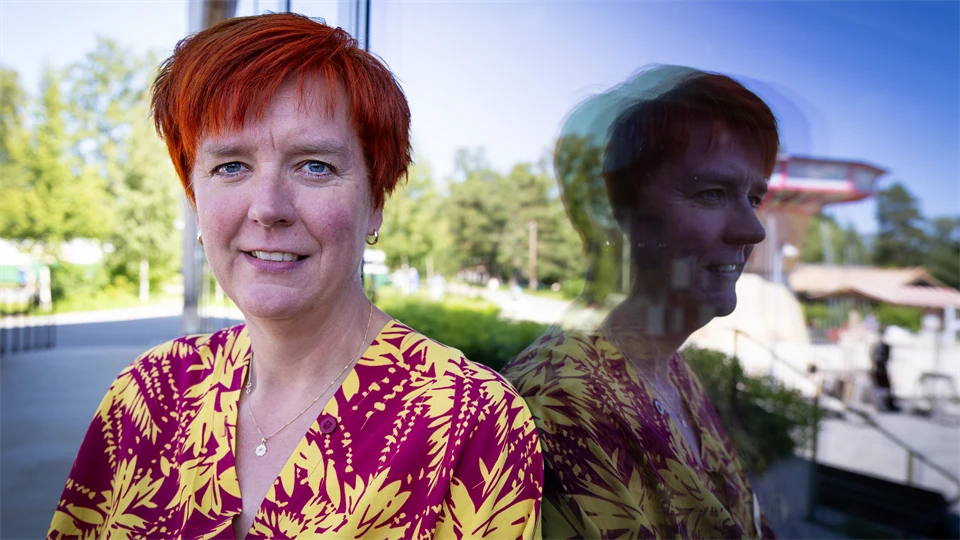From trapping pits to pharaohs – an archaeologist's life in time
What do trapping pits in the forest, old cemeteries and the era of the pharaohs have in common? They capture the interest of archaeologist Anna Engman. Meet the alumnus who will soon have worked for 30 years with Jämtland history.
Jamtli has just opened its doors for the day and families with children are pouring in with picnic baskets, carts and bags. Anna Engman, who started working at Jamtli in 1998, is taking the chaos in stride. On a daily basis, the county museum's archaeologists sit in the large building opposite Jamtli's entrance, but after 27 years at the same workplace, she knows all the passages, rooms and houses almost by heart. She has seen it all.
"Once a year, on the last day before the holiday, I usually go for a walk through history land," she says.
So when does she go on vacation?
"Today is the last day before the holiday.
Archaeology beyond the shovel
Anna Engman came to Östersund and Mid Sweden University as a 20-year-old from Kilafors in the autumn of 1995. She started studying history with the goal of becoming a teacher, but soon realized that the teaching profession was not for her. After three semesters of history, she started studying archaeology instead, and while she was studying, she got a job at Jamtli. After graduating and a few years at the Swedish Forest Agency, she got a permanent job here as an archaeologist. And here she is.
"The first thing people think of when you say you're an archaeologist is that you're an excavating archaeologist, that you're lying in a pit and digging for things. We don't do that so much here in Jämtland. Here we work with inventories and investigations out in the forest and land," she explains.
Trapping pits, settlements, summer pastures and iron-making sites are examples of what archaeologists in Jämtland are looking for. From Malung in the south to Arjeplog in the north, archaeologists travel around during the bare ground season from mid-May to the end of October. It becomes a bit of a lifestyle with many days away from the family, but the allure is to be able to put together some of the pieces of the puzzle that tell us about how we lived in the past.
"You often tend to see history as static, that everyone did the same thing for a certain period of time. But that was not the case, we can see that people did things differently, even in the same small village or on the same farm. There were different ways of solving things and history is not statically uniform, such things drive me," says Anna and adds:
"It's also a special feeling when you've been walking in the woods for two days and then suddenly you find a trapping pit and realize that there have been people here a long, long time ago.
Sometimes it is digging in pits
Of course, some things are cooler to find than others. Trapping pits are all well and good, but there are many of them in Jämtland. Archaeologists are usually called in when something big is to be built, such as a wind turbine or power line, but just over ten years ago, Anna was involved in excavations at Frösö church. Part of the wall was to be restored and it was already known that this was where the earliest Christian cemeteries were located, from the early 11th century.
"We knew when we were there that we would find skeletons and that is a bit special in itself, but we didn't quite know how old they would be. It was a bit cool.
It sounds a bit like you were lying in a pit digging?
– Haha yes. But most of the time we don't.
Holidays with history
We move out towards the area to take some pictures. The square is full of period dressed summer workers mixed with visitors in shorts and sunglasses. Maybe she will have time to take a walk through the area later," she says.
That's right, what does an archaeologist and history buff do on vacation?
"This year we're going to the Baltics and look at recent Cold War remains, we usually go somewhere where we can experience history.
She says that she is a "great lover of Egypt" and last year she took her husband and 10-year-old daughter on a cruise on the Nile, something of a dream trip.
Anna's mobile phone rings as we walk across the area, she answers and listens intently, says "yes" a few times before ending the call. It was her husband who called, she says, he wanted to let them know that they are also going to visit a weapons museum in Huskvarna during the holidays.
But first, a walk through history land awaits.
